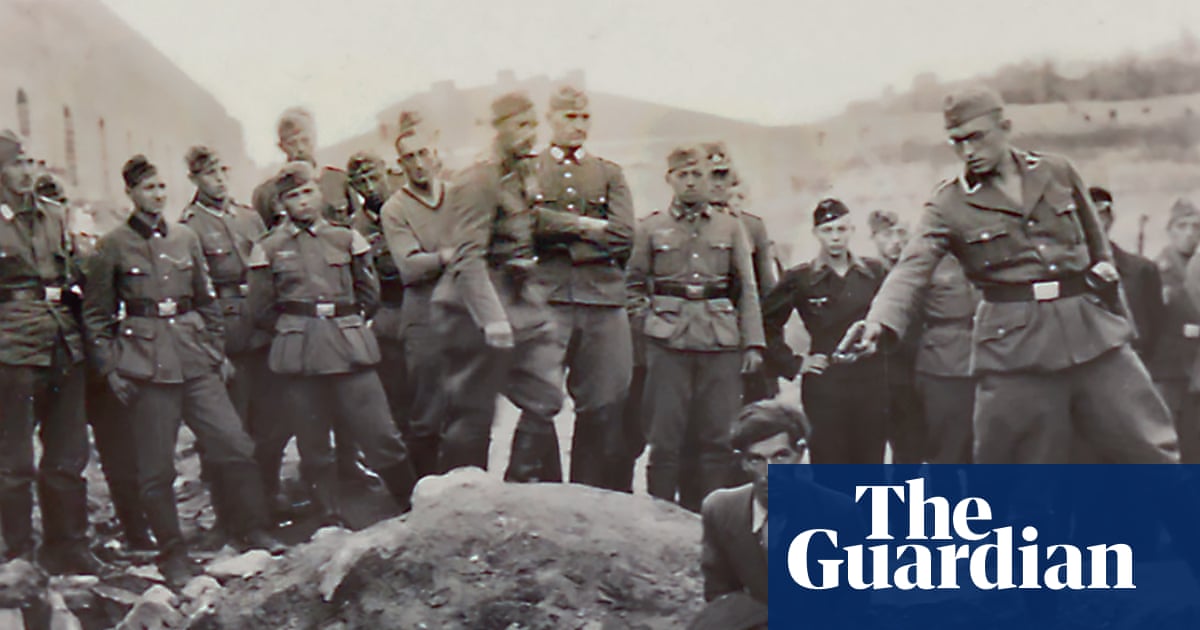It is one of the most chilling images of the Holocaust: a bespectacled Nazi soldier trains a pistol at the head of a resigned man kneeling in a suit before a pit full of corpses. German troops encircle the scene.
The picture taken in today’s Ukraine was long known, mistakenly, as The Last Jew in Vinnitsa, and was for decades shrouded in mystery.
The US-based German historian Jürgen Matthäus has for years painstakingly assembled the puzzle pieces and, with the help of artificial intelligence, is confident he has identified the killer.
According to findings, he has now published in the respected academic periodical Zeitschrift für Geschichtswissenschaft (Journal of Historical Studies), the SS carried out the massacre on 28 July 1941, most likely in the early afternoon, in the citadel of Berdychiv.
The city was for centuries a thriving centre of Jewish life. It is located 150km south-west of Kyiv and about 90km north of what is now known in English as Vinnytsia, which had long been considered falsely to be the site of the killings.
The Einsatzgruppe C commando, one of several mobile units deployed in the newly occupied Soviet Union, had been engaged in clearing the region of “Jews and partisans” days before a visit by Adolf Hitler.
Among them was Jakobus Onnen, a French, English and gym teacher born in 1906 in the German village of Tichelwarf, near the Dutch border.
Matthäus described an “incremental process” of traditional digging in dusty archives, lucky breaks, input from peers and the trailblazing involvement of volunteers from open-source journalism group Bellingcat.
“The match, from everything I hear from the technical experts, is unusually high in terms of the percentage the algorithm throws out there,” Matthäus said.
Preliminary research published last year allowed Matthäus to reveal the date, location and unit involved in the mass shooting, generating media coverage in Germany.
A reader came forward and said he believed, based on correspondence from the era in his family’s possession, that the gunman could be his wife’s uncle, Jakobus Onnen.
Relatives had destroyed letters from the eastern front from Onnen in the 1990s. But they still had pictures of him, which the Bellingcat volunteers were able to use for an AI image analysis.
“The AI experts tell me that this being a historical photo makes it more difficult to arrive at a 98 or 99.9% [match]” as often yielded in contemporary forensic work, Matthäus said.
But its strong likeness, combined with a mountain of circumstantial evidence, lent him credibility to publish.
“Digital tools in the humanities have massively increased in use, but it’s usually for the processing of mass data, not so much for qualitative analysis,” he said about the potential for the use of AI in his field.
“This is clearly not the silver bullet – this is one tool among many. The human factor remains key.”
Onnen, who had joined the Nazi party before Hitler took power in 1933, came from an educated family and in his youth enjoyed “travelling, studying languages”, Matthäus said.
“Then comes his deployment in the east and obviously here he stands,” he said. “Motivation is one of the most difficult questions to answer. The reason I think why he is posing there, the way he depicts himself – I think is meant to impress.”
Onnen was never promoted beyond a relatively lowly rank and was killed in battle in August 1943.
“Participating in a killing like that was taken for granted and didn’t give you any kind of bonus points in these murder units,” Matthäus said.
after newsletter promotion
He regretted that the letters Onnen sent home from the front which might have provided a window on to his ideology were destroyed. But he noted that the relative who had come forward about his suspected identity had read them decades before and described them as “banal”.
Matthäus was, until this spring, head of the research department of the United States Holocaust Memorial Museum in Washington DC, where he had worked since 1994.
His most recent book, Gerahmte Gewalt (Framed Violence), examines the photo albums compiled by Germans on the eastern front during the second world war.
He said it was “fairly certain” the image of the Berdychiv massacre, of which there are several prints, was taken by a fellow soldier and noted that such snapshots were seen as “trophies” from civilian bloodbaths.
Of the estimated 20,000 Jews in Berdychiv on the Germans’ arrival in 1941, only 15 remained in early 1944, according to the news outlet Der Spiegel, which reported on the new research.
“These mass executions in this format continued until the very last day of the German occupation in the east,” Matthäus said.
“I think this image should be just as important as the image of the gate in Auschwitz, because it shows us the hands-on nature, the direct confrontation between killer and person to be killed.”
He said extensive visual and written evidence sent home by German soldiers debunked the myth that the population at home was unaware of the genocide happening in their name.
Matthäus’s project also involves hunting for the identity of the victim in the Berdychiv photograph. He is collaborating with a Ukrainian colleague, Andrii Mahaletskyi, using Soviet-era records of local communities.
AI may also prove useful in this detective work, he said, if comparable images of the man in the suit can be found.
He acknowledged the difficulty of the task, noting that while the Nazis recorded names of those deported from western Europe to their concentration camp deaths in zealous detail, the majority of victims murdered in the east still remained nameless eight decades on.
“There were more than 1 million victims in the occupied Soviet Union,” he said. “Most of them are unknown, just as the killers intended.”









